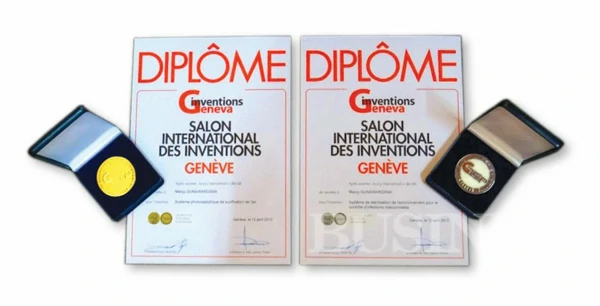
By Dilshan Senaratne
The inventive genius of Manju Gunawardene, clinched a gold and silver at the 41st Inventions Geneva Exhibition. Gunawardene received the laurels for development of the air purifying nano photocatalytic CFL lamp, a simple yet highly effective solution to contaminants in the atmosphere, which was awarded the Dassis Award at the National Innovations Exhibition earlier in 2012.
Having acquired a taste for innovation at a young age Gunawardene is no stranger to coveted awards. Today he has an illustrated career with many game-changing developments to his credit and has positioned himself at the helm of the industry having co-founded Hybrid Technologies. Highlights of his career are extensive ranging to a number of industries. His contributions have paved way for critical developments in the calibre of performance improvement systems in the apparel industry and the now largely popular lightning protection inbuilt sockets for electrical appliances. “The innovation culture is very simply focused on solutions, we solve day to day problems faced by the general public at a lower cost, more effectively. Uniqueness is the key, it’s a process of product development and now that has become a job for me,” comments Gunawardene.
The Wonder Bulb, an air purifying nano photocatalytic lamp received the Gold Award for its revolutionary air purifying function, which in addition to eliminating germs in the environment also converts harmful gases and fumes into harmless Nitrogen. A coating of photo catalytic Titanium Dioxide when applied to a CFL lamp, triggers a
mineral which decomposes organic matter, the result of which is air void of contaminants.
The Silver Award was won by a further developed version of the same technology, which is designed to assist in controlling hospital acquired infections (HAIs), a major health concern pitched on a global scale. “Now the biggest problem in hospitals are HAIs. You go with one problem and you come back as a dead body because of these infections. Most of the time these infections are caused by super bugs that are tolerant to antibiotics, so if you catch the bug, you die. You can’t get medicine but this can be handled with hospital infection control technology again using nano technology,” lamented Gunawardene. With approximately one in twenty hospital admissions contracting an HAI, the invention comes at an opportune time with a high level of global relevance.
Product development however is a long winded process with an extensive number of phases, which each require a specialised team of professionals. From the point of its inception as an idea, the product manifests many stages in its development cycle. Development, manufacturing, marketing and advertising are all components of the development cycle and the smooth transition of the product from one phase to another is vital to ensure its final form on par with industry standards.
”In Sri Lanka some of these sections are missing,” Gunawardene states with regard to the unfortunate missing links in our development cycle.
Manju Gunawardene is adamant that we are falling further behind in the rat-race to the elusive apex of technology, having “met the bus a couple of times but never having boarded it,” in his own words. “To develop as a country we should share our knowledge and that is the final remark, otherwise we’ll be stagnant for another decade and then it will be too late,” he stated stressing the importance of a dedicated administration system and industry focus.






